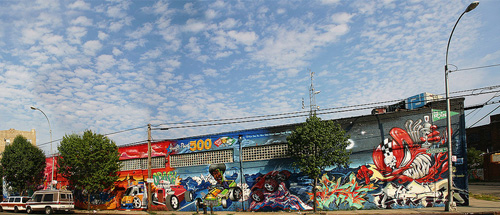Andrea Bernstein appears in the following:
Primary Day Preview
Monday, September 14, 2009
A Look at the NYC Comptroller's Race
Tuesday, August 25, 2009
WNYC Reporter Bob Hennelly visited The Brian Lehrer Show today to talk about the first debate in the citywide comptroller's race.
Listen to the whole show:
Apparently EVERYONE Does it Better!
Monday, August 24, 2009
Veteran foreign correspondent for The Washington Post, T.R. Reid traveled the world to compare the health care systems of rich democracies to the United States. He ...
Welcome to New York. Enjoy the Oysters
Thursday, August 20, 2009
New York City is the former oyster capitol of the world. There was a time when New York Harbor had over 350 square miles of oyster beds, half of the world supply. Street-side oyster vendors were as popular as hot dog carts are today. Local oysters were a delicious treat, they cleaned the waterways and they bolstered aquatic wildlife. But oysters have since disappeared from New York Harbor, mostly because of human intervention. Now, there are new efforts to reintroduce them in Jamaica Bay.
Mark Kurlansky, the author of The Big Oyster: History on the Half Shell, and Jeffrey Levinton, distinguished professor of ecology and evolution at SUNY Stony Brook, visit The Brian Lehrer Show to talk about the history of oysters in New York Harbor, and plans to reintroduce them.
Listen to the whole show:
Andrea Bernstein: Let's start with a history. I'm very intrigued by this idea of oysters being sold like hot dogs.
Mark Kurlansky: Well, oysters are an animal that lives in brackish water, which is water that's saltier than fresh water but not as salty as the sea. Estuaries of rivers, places where fresh water dumps into sea water are the ideal climate. New Yorkers too easily forget that the five boroughs of New York City are at the magnificent estuary of the Hudson River and the estuary used to be full of oysters.
That means the East River and the Hudson and out in the harbor around Staten Island and Liberty Island and Ellis Island, which used to be called Big and Little Oyster Island. The coast of the Bronx, back when the Bronx had a non-industrial coast, and the Brooklyn coast into Queens and Jamaica...it was all full of oysters. There was this tremendous natural resource that was identified with New York so that, for centuries, if somebody said they were going to New York City, the typical response was 'Enjoy the oysters!' They were sold everywhere.
Bernstein: Until when?
Kurlansky: Until 1927 when the last bed was closed. A process began in the 1880's when they started understanding about germs. There were chronic epidemics in New York history and they never really understood the cause of them. Everybody sort of assumed that it must be caused by foreigners and immigration and poverty. Then they started understanding what really caused things like cholera and developed the ability to trace them. They kept tracing them to oyster beds. One by one, with each disease outbreak, a bed was closed. The last bed, which was in Raritan Bay between Staten Island and New Jersey, was closed in 1927. Then it was over.
Egyptian President to White House Today
Tuesday, August 18, 2009
From "The Hammer" to The Hustle
Tuesday, August 18, 2009
Testing the First Amendment Online
Tuesday, August 18, 2009
Dancing with the Stars with Andy Borowitz
Tuesday, August 18, 2009
The Elderly on Health Care Reform
Tuesday, August 18, 2009
The Political Effects of the Health Care Debate
Tuesday, August 18, 2009
Schools Gear up for Swine Flu Season
Tuesday, August 18, 2009
Monitoring Afghan Elections
Tuesday, August 18, 2009
How Do You Spell Recovery?
Tuesday, August 18, 2009
The Supreme Court Steps In
Tuesday, August 18, 2009
Translating the Health Care Debate
Tuesday, August 18, 2009
Improving Troops' Mental Resiliency
Monday, August 17, 2009
Bronx Tops in Poverty and Unemployment, 14th in Stimulus
Monday, August 10, 2009
Bronx Tops in Poverty and Unemployment, 14th in Stimulus
Monday, August 10, 2009
New York, NY —
Under the federal stimulus bill, areas suffering economic distress are supposed to get the most help. But while Bronx County has the highest unemployment and the most poverty in New York, 13 other counties are getting more stimulus funding per capita. That’s according to the ...
Velib? Ici?
Monday, August 03, 2009
If you've been to Paris, or Rio, or Barcelona, you might have noticed denizens swiping cards, getting bikes, and tooling merrily through the streets until they leave their bike where they're going. A Zipcar, but for bikes, and no reservation necessary. Such systems have long been the apple of Transportation ...
NYC Welcomes Paris-Style Bike Share
Monday, August 03, 2009
New York, NY —
New York City Transportation officials are looking at bringing a Paris-style bike share system to New York, and for the next three Saturdays, New Yorkers will have a chance to try it out.
In Paris, Montreal, and Barcelona, residents and tourists alike can swipe a card, ...








